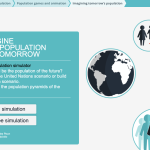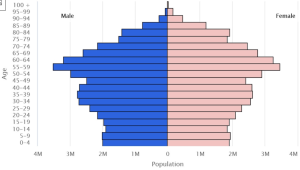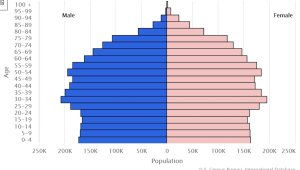Chapter 2: Population and Health
2.5 Population Growth
2.5.1 The Population Debate
In 1798, Thomas Malthus published a short but revolutionary work called “An Essay on the Principle of Population.” In that essay, Malthus states that future population growth would be determined by two simple facts: 1. food is necessary for human survival and 2. men and women will continue to produce offspring.
To manage population growth with respect to food supply, Malthus proposed methods which he described as preventive or positive checks:
- A preventive check according to Malthus could occur if population growth changes. This may occur due to celibacy and chastity but also because of the use of contraception or acts of infanticide or abortion.[29] In other words, preventive checks control the population by reducing fertility rates.[30]
- A positive check is any event or circumstance such as war, famine, and disease that shortens the human life span.
Figure 2.5.1 Thomas Robert Malthus and The Malthusian Catastrophe Simplistically Illustrated. Malthus posited that the population will grow much faster than food production, eventually leading to starvation, wars, and diseases.
Source: “Thomas Robert Malthus” by John Linnell via Wikimedia Commons is licensed under CC BY 4.0. “The Malthusian Catastrophe Simplistically Illustrated” by Kravietz and Jarry1250 via Wikimedia Commons is licensed under CC BY-SA 3.0.
His view is that if the population is not restrained population growth will occur exponentially. He also argues that agricultural production of food could only grow arithmetically (see Figure 2.5.1).
Why is Thomas Malthus’ prediction wrong SO FAR?
As societies industrialize, birth rates tend to fall. This decline is influenced by the fact that, in most industrialized societies, children represent a significant financial expense, requiring investment in education, food, and other necessities, rather than contributing to household income. Additionally, retirees increasingly rely on social safety nets such as social security, reducing the traditional reliance on grown children for support in old age. At the same time, improvements in healthcare and living conditions have led to a decrease in infant mortality rates, allowing more children to reach adulthood.
Advances in farming and distribution technologies have significantly increased productivity and reduced food spoilage. Innovations such as genetic engineering, synthetic fertilizers, and pesticides have boosted agricultural yields. Furthermore, improvements in food transport, storage (refrigeration), and distribution (canning) have minimized spoilage and waste, ensuring a more reliable food supply. These technological advancements have collectively enhanced the efficiency and sustainability of food production and distribution systems in industrialized societies.
Why do we still hear about famines today?
Some countries and regions face significant challenges in producing enough food due to a lack of essential resources, such as quality land and water, and political instability. These areas often struggle with poor soil quality, limited access to fresh water for irrigation, and adverse climate conditions that hinder agricultural productivity. Political instability further exacerbates these issues by disrupting farming activities and displacing communities, making consistent food production difficult.
In addition to production challenges, many of these countries and regions cannot buy or receive much-needed food due to a lack of financial resources or political will. Economic hardships prevent them from purchasing food on the international market, while political corruption or indifference can stifle efforts to address food shortages. Moreover, inadequate infrastructure, such as poor roads and storage facilities, hampers the effective delivery and distribution of food aid. Political instability can also interrupt aid delivery and create unsafe conditions for humanitarian workers, leaving vulnerable populations without reliable access to food.
Wars in South Sudan, Nigeria, Somalia, and Yemen are threatening to starve 20 million people. In all four countries, it’s war that’s threatened to put 20 million people at risk of starvation. (Source: Vox).
Overpopulation results when a place or country fails to generate enough resources to support its population. Compare the size of different countries in the world with the number of people that they hold in the side-by-side maps below. Note that some relatively smaller countries (e.g. India) have much larger populations than much larger countries (e.g. Australia).

Source: “Equal-Area Map” and “Cartogram Map” The cartogram was produced using the go-cart.io website using the Fast Flow-based Algorithm developed by Gastner, Seguy, and More in 2018. go-cart.io website © Michael T. Gastner. Retrieved from Fundamentals of Human Geography by Wing Cheung. CC BY 4.0.
Visit these maps with interactive capabilities on the Go.Cart website.
YOUR TASK
Click on the UN population simulator to answer the following questions:

- When will the world see 9 billion people?
- Will the world see 10 billion people? If so, when?
- Will the world see 11 billion people? If so, when?
Check out this YouTube on population growth:
2.5.2 Food Supply for All
While new technologies have helped to increase food production, there are not enough emerging technologies to handle supply and demand. Adding to the problem is the fact that many insects have developed a resistance to pesticides. These problems have caused a slowdown and a leveling-off of food production in many regions of the world. Without breakthroughs in safe and sustainable food production and sound and consistent food distribution methods, the food supply may not keep up with population growth.
Once the planet reaches its carrying capacity, it will support the maximum number of people without causing environmental degradation. To avoid reaching this critical point, we need to implement controls such as avoiding food waste, limiting massive deforestation in boreal and rainforests, combating desertification that encroaches on arable land, increasing aquaculture to help oceans recover from overfishing, and curbing anthropogenic climate change. These measures are essential to maintaining a sustainable balance between human needs and the environment’s ability to support them.
At the local level, the carrying capacity, or the number of people a place can support, depends on each person’s ecological footprint, the natural resources available, and the technology that extends the use of these limited resources. A smaller ecological footprint means less strain on local resources, while the availability of natural resources such as water, fertile soil, and energy sources directly influences how many people an area can sustain. Technological advancements can help maximize the efficient use of resources, ensuring that a community can support its population without depleting its environmental assets.
YOUR TASK

How many planets does it take to sustain your personal lifestyle?
What is your Ecological Footprint? How many planets does it take to support your lifestyle? Take this free Ecological Footprint quiz to find out!
2.5.3 Population Policies
Governments and other entities can dramatically influence population change to increase or decrease population growth in their country by promoting anti-natalist or pro-natalist policies.
Many countries in Europe have had negative population growth for decades. The population policies of two selected European countries may serve as testimony to their efforts to increase the TFR: Germany and Norway. China will serve as an example of a country that acted to curb its massive population.

Source: “2023 Germany Population Pyramid” retrieved from CIA The World Factbook
Germany faces a serious labor shortage as baby boomers retire, resulting in a significant loss of qualified workers and increased fiscal burdens from pension and health benefits. Historically, social security issues stem from longer life expectancies; in the 1950s, people typically died shortly after retirement, but today, they live many years longer, drawing pensions and benefits. To address these challenges, reforms are needed, such as raising the retirement age and promoting flexible employment for older individuals. While recent high immigration levels have helped, Germany must better align immigration policies with labor market needs, maybe drawing inspiration from the effective models of Canada[1], in particular.
Germany and Norway both employ pro-natal policies aimed at encouraging childbirth and supporting families. In Germany, measures such as parental leave, subsidized childcare, and financial incentives, including parental allowance and child benefits, are integral parts of their approach. Germany offers generous maternal leave policies with pay to support new mothers during the crucial postnatal period. Expectant mothers are entitled to statutory maternity leave, which typically begins six weeks before the expected due date and extends for a minimum of eight weeks after childbirth. During this period, mothers receive maternity pay, which covers around 65-100% of their previous net income, depending on their employment status and collective bargaining agreements. The duration of maternity leave can be extended up to three years under the Elternzeit (parental leave) scheme, during which a portion of the salary is paid through parental allowance. Additionally, Germany’s “Family-friendly University” initiative facilitates the balancing of academic pursuits and family life for students and researchers.
China: In the late 1960’s the Chinese government recognized that their approach to populating the country after the famine fo 1959-1961 that cost over 30 million people’s lives was geared to severely overpopulating the country. As a consequence they began advocating for family planning in urban and rural areas as early as 1962. In 1980, China took a dramatic step to reduce their swelling population with its One-Child Policy. Each Han-Chinese family (husband and wife) could legally have only one child. Families that followed this policy were often given more money by the government or better housing. If a family illegally had another child, they would be fined heavily. Children born illegally cannot attend school and have a difficult time finding jobs, getting government licenses, or even getting married. Some have reported that the government would force abortions on families with more than one child. One of the significant consequences of this policy was a dramatic increase in abortions and infanticides, especially females. This specific focus on eliminating women is called gendercide (see sidebar). Female infanticide is linked directly to a global cultural trend that privileges males over females, baby boys are desired, especially if the family is only allowed, one child. The success of the One-Child-Policy resulted in negative growth so the government was replaced this policy in 2016 with the Two-Child-Policy which was followed by a Three-Child-Policy in 2020. Neither of these later attempts seem to come to fruition.
Global Population Control: After the two great world wars, the United Nations Population Commission and the International Planned Parenthood Federation began advocating for more global population control. Their efforts aim to address the challenges of rapid population growth and its impact on global resources and development. One of their primary focuses is changing cultural attitudes that contribute to high or low population rates, encouraging societies to adopt more sustainable family planning practices. Additionally, they emphasize providing contraception to least developed countries (LDCs), ensuring that people have access to the tools they need to manage their reproductive health.
These groups also work on helping countries study population trends by improving census counts, which provides vital data for informed decision-making and policy development. Another crucial aspect of their advocacy is empowering women and emphasizing gender equality. By promoting women’s education, economic opportunities, and reproductive rights, they aim to create a more balanced and equitable society, which in turn can lead to more sustainable population growth rates.
It is believed that worldwide, over 60 percent of women between ages 15-49 use some form of contraception. This varies regionally. In the United States, contraception use is at nearly 75 percent, whereas in Africa, it is around 30 percent. The consensus today is that the focus on population planning should be on gender equality and improving the social status of women around the world. This is the focus of the International Conference on Population and Development.
Religious organizations are also concerned with population growth; however, they focus on contraception issues and not strictly population growth. Some religions and political entities find contraception use immoral which has influenced some governments to make access to and use of them illegal.
Watch the World Population video.
- Canada achieved a positive approach to immigration through several key strategies:
- Point-Based System: Canada uses a merit-based point system to select immigrants, prioritizing skills, education, work experience, and language proficiency, ensuring that immigrants can contribute effectively to the economy.
- Multiculturalism Policy: Canada's official policy of multiculturalism promotes the preservation of cultural diversity and encourages immigrants to maintain their cultural heritage while integrating into Canadian society.
- Settlement Services: Comprehensive settlement services, including language training, employment assistance, and community support programs, help immigrants integrate smoothly into Canadian society.
- Family Reunification: Canada places a strong emphasis on family reunification, allowing immigrants to bring family members to join them, which supports social stability and community integration.
- Provincial Nominee Programs (to be adapted for the German environment): These programs allow provinces and territories to address specific labor market needs by nominating immigrants with skills that are in demand locally.
- Inclusive Attitudes: Public attitudes in Canada generally support immigration, viewing it as a positive force for economic growth and cultural enrichment, which is reinforced by government policies and public discourse.
- Economic Focus: Immigration policies are designed to address labor market shortages and support economic growth, with programs tailored to attract entrepreneurs, investors, and skilled workers. ↵





